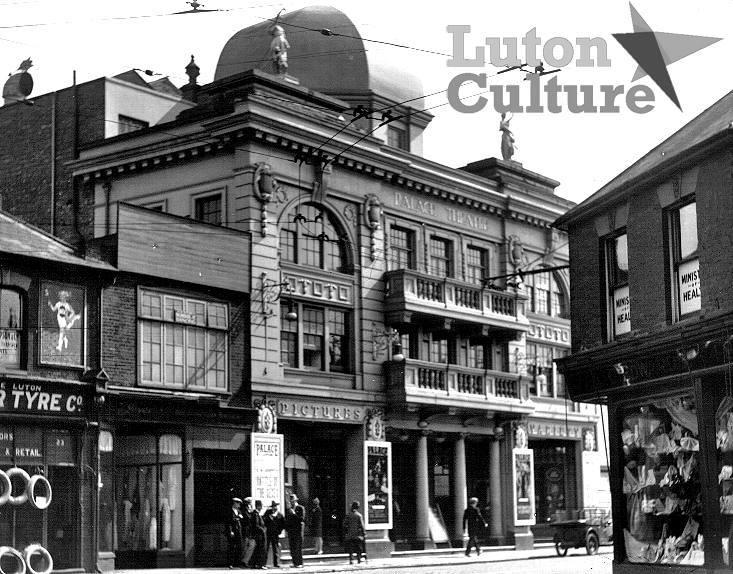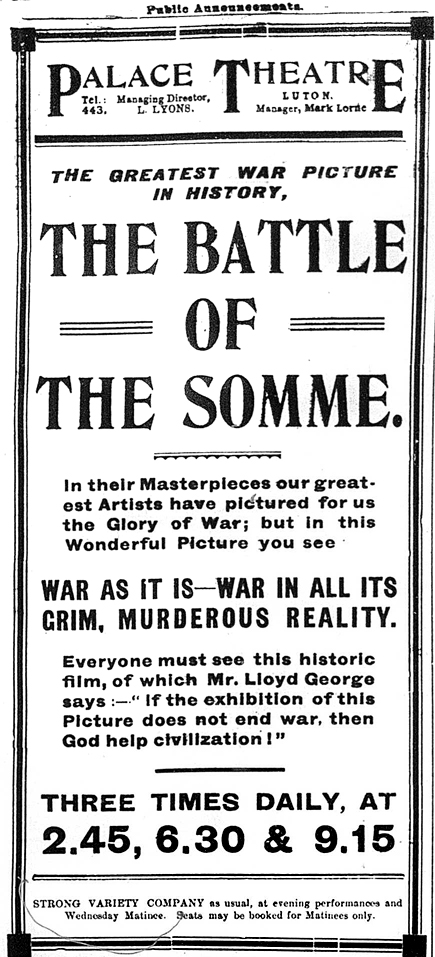
Still one of the all-time biggest cinema box office crowd-pullers in Britain, the ground-breaking film The Battle of the Somme was to be shown to Luton audiences for the first time during a week-long run beginning on Monday, October 2nd, 1916, at the Palace Cinema in Mill Street. More than 20 million people nationwide would see the film at their local picture palaces.
Previewing the film in its October 2nd edition, the Luton Reporter newspaper described it as the great official war film. It was expected to be shown to crowded houses throughout the week. The Minister for War [David Lloyd George] had declared it to be a picture everyone ought to see - the most important and imposing picture of the war that had yet been produced.
 "This great picture, which was taken under the direction of the War Office by operators who risked their lives to give the people of the British Empire a true impression of the nature of this, the greatest of all wars, is not to be described as an entertainment. Rather it is a living, moving panorama of the first stage of what everyone must hope is the last phase of the greatest struggle in which our country has ever been engaged - the struggle to preserve the liberties of Europe against an arrogant foe.
"This great picture, which was taken under the direction of the War Office by operators who risked their lives to give the people of the British Empire a true impression of the nature of this, the greatest of all wars, is not to be described as an entertainment. Rather it is a living, moving panorama of the first stage of what everyone must hope is the last phase of the greatest struggle in which our country has ever been engaged - the struggle to preserve the liberties of Europe against an arrogant foe.
"There is no make-believe in the scenes which are so vividly shown in this film. It is no play-acting. It is war, grim and desperate - so real that its reality comes as a shock to the citizen who does not know the fearful toll which war demands.
"We have been long enough at war to know and to feel some of its effects, but, more fortunately placed than our friends and Allies across the Channel, we are removed from its terrible realism. This picture brings it home to us. It reproduces before our eyes the scenes in which our fighting men have played so gallant a part.
"In its epitome of the war, The Battle of the Somme illustrates alike the destructiveness of the modern machinery of war, the stupendous struggle for mastery, the super-human endurance of the men, the mobility of their suffering, and their courage in the face of death.
"Like as the lifting of a veil, the grim tragedy of the war is revealed to those who until now have only realised the tragic significance of the European upheaval through the medium of newspaper reports.
"The first part of the picture shows the preparatory action over the dates from June 25th to the 30th, and a division waiting to go forward. There with the Buffs, the Suffolks and the Welsh Fusiliers is seen a platoon of brave Bedfords, our own county regiment, who have taken such a gallant and glorious part in the fighting, moving up in the evening before the attack.
"The next series brings us nearer. We see the men fixing wire cutters to their rifles for forcing a way through the German barbed wire entanglements. A field battery gallops into action, Howitzers are revealed in their screens throwing 1,400-pound shells, and looking over the field through the eye of the camera we see the ominous splash, the upheavals of earth which follow the descent of the great shells in the enemy lines, and the cloud-like puff of shrapnel bursting over the German trenches.
"And then the great scene of all, the leap from the trenches at dawn on the memorable first of July, man falling 'ere they can leave the parapet, the charge across no-man's-land in the face of deadly fire - then the assault.
"Meanwhile goes on the noble work of succour by the men of the Red Cross, given to friend and foe alike. Deeds of rescue come into the picture. British Tommies are seen rescuing a comrade under shell fire - an inspiring sight. One man crosses the trenches bearing a wounded comrade on his back, crawls through the mass of broken barbed wire, and bravely struggles with his burden to safety.
"And so the battle goes on until the ground is won. The artillery threads its way through the lanes of dead and taken up their new positions, British wounded and nerve-shattered German prisoners are seen arriving. A British officer is seen giving drink and British Tommies offering cigarettes to captured Germans. There are battle police rounding up more prisoners, and helping to bring in wounded from no-man's-land, and prisoners escorted into compounds to await transportation.
"A dread picture shows groups of German dead on the field of battle, and huddled in the disordered trenches which they had thought were impregnable.
"Later on are witnessed our men assembling for roll call, tired but cheery groups of victorious Tommies, laughing and chatting, and a sample of the British Army off to continue the advance.
"These are only a few of the 60 or more incidents of the film which go to make up what has been described as 'the greatest advocate of peace the world has known these 19 centuries'."
The Battle of the Somme was in five parts and took an hour and a quarter to show.

